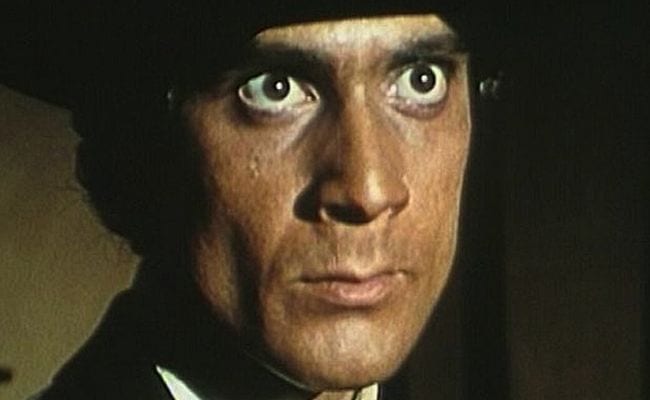
For a spaghetti western, Twice a Judas (1969) develops slowly; its plot is as meandering as a monk walking in the moonlight. The film begins by showing what looks like two bodies laying dead atop a desolate desert mountain, but when a frenzied flock of vultures begin pecking away at them, one of the the bodies jumps up and unloads several rounds from a shotgun into the flying scavengers. This shotgun-wielding body is Luke Barrett (Antonio Sabato). Although he is alive, he has an extreme case of amnesia. “It’s inside my head,” he says at one point. “This blackness. I can’t remember anything. I don’t even know who I am.”
He walks to the nearest town to get himself a whiskey at a saloon. While sitting at the bar, a man dressed in black with bulging eyes approaches him and asks where he’s been. This man is named Charlie (Franco Leo), and he tells Luke that together they have been hired by someone to assassinate someone. Who these someones are, neither we nor Luke knows. But as the film crawls forward, we learn that Luke’s own brother, Dingus Barrett (Klaus Kinski), is the target, and Murphy the Banker (Narcisco Ibanez Menta) is the client.
An intense, long-running conflict exists between Murphy and Dingus over the farmland surrounding the town — Murphy is trying to buy it all up, and Dingus is resisting — and the two are out for each other’s blood. “You’re going against progress,” Murphy tells Dingus, “and nobody can stop progress.” Meanwhile, no one is telling Luke the truth about this conflict over the land and the role his own past, such as the death of his family, plays in it. The only one who provides any clues is the passive drunk Doc Russell (José Calvo), and the clues he provides eventually indict Dingus in a conspiracy rooted in the darkest of family secrets. These secrets, however, aren’t revealed until the very end of the film in a lengthy flashback sequence.
Like baseball or fishing, this snail-like pace of Twice a Judas will turn many people off. But a certain percentage of spaghetti western fans will find its leisurely approach as stimulating as a hot bath on a winter evening. Just as some sports fans enjoy the mental face-off that is every at-bat in baseball more than the constant scoring and dunking on a basketball court and how some outdoorsmen find the meditative waiting leading up to the nibble from a fish more rewarding than the instant adrenaline rush of jumping from a plane and diving down through the sky, some fans of spaghetti westerns will appreciate the slow, almost hypnotic, pace of Twice a Judas more than the relentless action in films like If You Meet Sartana… Pray for Your Death (1968).
But even if you appreciate its unhurried nature, the plot is problematic because it develops oddly. The dead body that Luke wakes up next to is referenced throughout the story, with the local sheriff and Charlie the assassin asking what happened to the man he was with. Yet we never, as far as I’m aware, find out who this man is or why so much emphasis is placed on him. But what is more baffling is how the plot builds and builds and builds and doesn’t climax until the end, just a few minutes before it resolves. This could have worked fine if there was enough action scattered throughout the film, but there isn’t. Only a few shots are fired before the big shoot-out scene, which is fulfilling enough, but the resolution that follows it is too brief and doesn’t have the bite one expects after waiting so long.
But the acting from Klaus Kinski makes up for the irregular plot of Twice a Judas and even its lack of action. The character he plays, Dingus, is unforgettable. As we learn by the end of the film, he is a half-Native American tyrant who knows no limits when it comes to protecting the land he believes is his and exacting revenge on those who try to take it from him. This character of Dingus has that same single-minded obsession that Kinski would later extend and perfect with his legendary Werner Herzog directed characters, Aguirre in Aguirre, the Wrath of God (1972) and Fitzcarraldo in Fitzcarraldo (1982).
Because he is given more screen-time in Twice a Judas than in his typical Spaghetti Western supporting-roles — for instance, as the hunch-back in For A Few Dollars More (1969) or the scalp collector in Shanghai Joe (1972) — he is able to give us a more subtle performance than fans of this genre are used to seeing from him. The shots showing him standing atop a hill staring at a large wooden cross while draped in a black-cape and surrounded by the land he is fighting to protect are stunning, and the razor sharp profile and insanity in his eyes he is famous for evoke a mysterious torment. It reminds me of Robert De Niro and his unparalleled ability to tell so much by doing so little. Kinski is, without a doubt, a treasure that all spaghetti western fans should hold dear.
There are some great moments of raw B-movie creativity here, such as the frantic vultures at the start, the scene where Luke dodges bullets as we watch through the bobbing scope, the Irish Wolfhound that helps with the kills in the climatic action sequence, and the final, goose-bump causing scene where a stuntman goes tumbling down a rocky cliff. Throw all these together and you have a spaghetti western that is, in spite of its many flaws, better than most in the genre.


![Call for Papers: All Things Reconsidered [MUSIC] May-August 2024](https://www.popmatters.com/wp-content/uploads/2024/04/all-things-reconsidered-call-music-may-2024-720x380.jpg)



